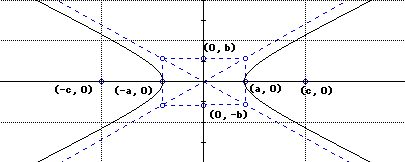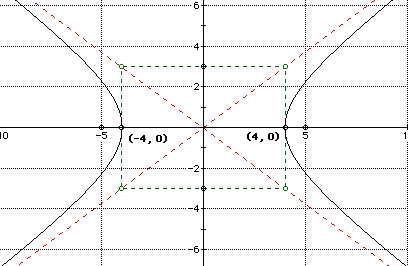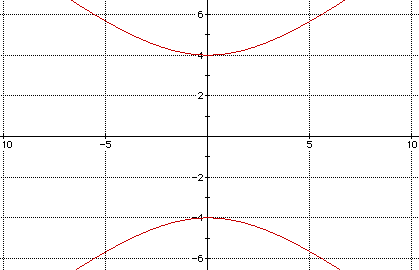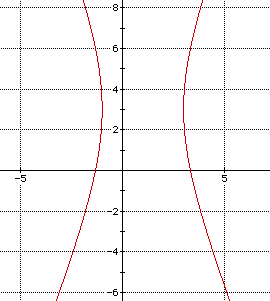
The equation (in standard form) of a hyperbola centered at the origin with foci (c, 0) and (-c, 0) lying on the x-axis is (x2/a2) - (y2/b2) = 1, where c2 = a2 + b2.
The points (a, 0) and (-a, 0) are the vertices, and the line segment joining them is the transvers axis. The line segment from (0, b) to (0,-b) is the conjugate axis. The hyperbola is symmetric with respect to the origin, and the axes are lines of symmetry.
We can see from the picture below that the branches of the hyperbola approach two lines. These are called asymptotes. A line is an asymptote to a curve if the distance between a point on the curve and the line approaches zero as the point moves farther from the origin. What are the equations of the asymptotes?

You should see that the equations of the asymptotes are y =(b/a)x and y = -(b/a)x.
First, we need to put the equation into standard form; that is, the right side should equal 1. To do this, divide both sides by 144.
(9x2/144) - (16y2/144) = 1
(x2/16) - (y2/9) =1
So, a = 4 and b = 3. Since c2 = a2 + b2, c = 5. Therefore, our vertices are (4,0) and (-4,0), and the foci are (5,0) and (-5,0). The asymptotes for this graph are y = (3/4)x and y = (-3/4)x.
To graph a hyperbola by hand, let's first graph the asymptotes. Draw the rectangle formed by x=4, x=-4, y = 3, and y = -3. By extending the diagonals of this rectangle, we have the asymptotes. Now, label the foci and vertices, and draw in the hyperbola. Check your graph with the graph below.

Point for thought: The x-intercepts of the graph occur at the vertices. Are there any y-intercepts? Why aren't there?
a. 4x2 - 9y2 = 36
b. x2 - y2 = 16
Graph the following equation on your graphing program or calculator: 25y2 - 16x2 = 400
What is different about this graph? Discuss with a classmate.

Before this example, the hyperbolas we have explored have been lying on the x-axis. If the hyperbola were on the y-axis, what things would change?
1. The standard form is (y2/b2) - (x2/a2) = 1, where c2 = a2 + b2
2. The vertices are (0, b) and (0, -b).
3. The slopes of the asymptotes remain the same.
4. The only intercepts are the y-intercepts. They occur at the vertices.
So, putting a hyperbola that lies on the y-axis in standard form is no more difficult than what we have already done.
For the above example, the vertices are (0, 4) and (0, -4) and the foci are (0, sqrt41) and (0, -sqrt41). The asynptotes are y = (4/5)x and y = -(4/5)x.
Note: The positive squared term determines on which axis the hyperbola lies. If y2 is positive, the hyperbola lies on the y-axis. Therefore, the vertices are found from b2, not a2.
c. y2 - x2 = 25
d. y2 - 25x2 = 225
e. Based on what you have learned and what you can infer, make a chart that compares the attributes (standard form, intercepts, transverse axis, conjugate axis, foci, vertices, asymptotes) of a hyperbola lying on the x-axis with a hyperbola lying on the y-axis.
f. A hyperbola has foci F1 = (c, 0) and F2 = (-c, 0) on the x-axis. Let P(x, y) be any point in the first quadrant, and PF2 - PF1 = 2a. Use the distance formula to derive the standard form equation of a hyperbola on the x-axis. (Hint: PF2 - PF1 = sqrt((x + c)2 + y2)).
On Algebra Expressor, graph 25x2 - 50x - 4y2 + 24y = 111. What do notice about this graph? Can you pick out the vertices, foci, and asymptotes? Discuss with a classmate.

Quite often, hyperbolas are not centered at the origin or lying on one of the axes. So, we must alter our standard forms and means of determining the attributes of the graphs.
Consider the formula for a circle: A circle with center (h, k) and radius r has the equation
(x - h)2 + (y - k)2 = r2
We are going to use a similar idea for the general form of a hyperbola.
Given a hyperbola with center (h, k), the foci must change to account for h and k. The original foci were (c, 0) and (-c, 0). The new standard foci are (h + c, k) and (h - c, k).
Therefore, our formula is (((x - h)2)/a2) - (((y - k)2)/b2) = 1.
Now, go back to the example at the beginning of the lesson and locate the center and foci. Can you write the standard formula from this information?
For the hyperbola 4x2 - y2 + 24x + 4y + 28 = 0, find the center, vertices, foci, and asymptotes. Draw the graph.
First, we must complete the square.
4(x2 + 6x + ) - (y2 - 4y + ) = -28
4(x2 + 6x + 9) - (y2 - 4y + 4) = -28 + (4)(9) + (-1)(4)
4((x + 3)2)- ((y - 2)2) = 4
((x + 3)2) - (((y - 2)2)/4) = 1
The center is (-3, 2), a = 1, b = 2, and c = sqrt(5). So, the foci are (-3 + sqrt5, 2) and (-3 - sqrt5, 2). The vertices are (-3 + 1, 2) and (-3 -1, 2), or (-2, 2) and (-4, 2).
The asymptotes are also translated. Had the graph been centered at the origin, the asymptotes would have been y = 2x and y = -2x. However, these are translated to the left 3 and up 2. Using our knowledge of transformations, we get the new asymptotes to be y - 2 = 2(x + 3) and y -2 = -2(x + 3).
To graph, graph the asymptotes, foci, and vertices. Then draw in the graph of the hyperbola.

g. 4x2 - 25y2 - 8x - 100y - 196 = 0
h. ((y-2)2/9) - ((x + 1)2/16) = 1
i. Hyperbolas centered at the origin lying on separate axes with the same a and b are called conjugate hyperbolas. On your graphing utility, graph a pair of conjugate hyperbolas on the same coordinate axes. What do you observe? Do they intersect? If so, at what points? Look at the attributes of both graphs. What is similar? What is different?
Graph xy = - (1/2)
What are the asymptotes? In what quadrants does the hyperbola lie?
Graph xy = (1/2)
What are the asymptotes? In what quadrants does the hyperbola lie?
Make a conjecture about the nature of hyperbolas in the form xy = c. What are the asymptotes? How can you determine the quadrants the branches inhabit without graphing the hyperbola?
j. Graph xy = 3
k. Graph xy = -12
Back to Conic Section Home Page
For each hyperbola, find the center, vertices, foci, asymptotes, and intercepts. Then draw a graph.
1. x2 - 4y2 = 4
2. y2 - 4x2 = 4
3. ((x - 2)2/9) - (y + 5)2 = 1
4. 36x2 - y2 - 24x + 6y - 41 = 0
Graph.
5. xy = 1
6. xy = - (2/3)
Find equations of the hyperbolas satisfying the given conditions.
7. vertices at (1, 0) and (-1, 0) and foci at (2, 0) and (-2, 0)
8. asymptotes y = (3/2)x and y = - (3/2)x and one vertex (2, 0)
9. A rifle at A fires a bullet which hits a target at B. A person at C hears simultaneously the sound of the rifle shot and the sound of the bullet hitting the target. Describe the set of all such points C.
10. Solve the equation 9x2 - 16y2 = 144 for y2. What happens to this equation a |x| changes? What are the equations of the asymptotes of the graph? (Use spreadsheet and expressor.)
11. What happens to the graph of xy = k as |k| changes?
12. Graph the inequality: 25y2 - 36x2 > 900
13. Prove that conics with equations 16x2 - 9y2 = 144 and 11x2 + 36y2 = 396 have the same foci. (Hint: What type of conic is the second equation?)
1. Graph and label the vertices, center, foci, asymptotes, and intercepts.
4y2 - 9x2 = 36
2. Which is the equation of a hyperbola?
a. 2x2 + 4x + y2 - 6y = 20
b. 3x + 2y - y2 - 4 = 0
c. x2 + 3x - y= 16
d. 4x2 - 8x - 4y2 + 8y = 16
3. Identify the vertices.
((x - 3)2/4) - (y2/16) = 1
4. Determine the equation of the hyperbola with asymptotes y = x and y = -x and foci (0, 1) and (0, -1).
5. Determine the equation of the hyperbola with length of transverse axis = 6, length of conjugate axis = 2, foci on y-axis, center at origin.
6. Is it possible to draw every point of a hyperbola? Why or why not?
Back to Conic Section Home Page